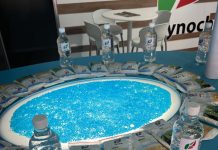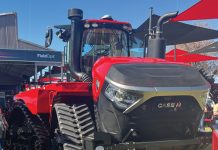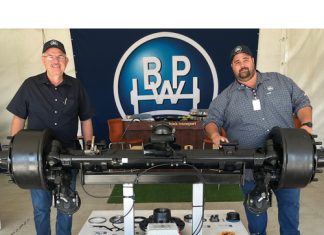Two new herbicide products that will be valuable tools to combat weed resistance are now available to producers in South Africa. Produced by Corteva Agriscience™, Quelex™ 200 WG (L10759) and Tarzec™ 320 WG (L10760) are registered for post-emergence application in wheat.
Both products contain a new active ingredient with trade name Arylex™, the first member of a new range of synthetic auxin broadleaf herbicides. Arylex’s active common name is Halauxifen-methyl and is a growth regulator mode-of-action herbicide.
The Arylex key benefits include the following:
- Effective post-emergence control of many common and economically damaging broadleaf weeds in cereals.
- Consistent weed control across variable climatic conditions (cold and dry conditions) allows for flexibility of application.
- Low use rates resulting in low environmental load of the herbicide.
- Alternative mode of action to help manage resistant weed biotypes.
- Rapid degradation in soil and plant tissues allowing for crop rotation flexibility.
- Favourable environmental and toxicological profile.
Quelex 200 WG
The product is an early post-emergence broadleaf weed herbicide in wheat in the Western Cape and the summer rainfall region. It is used to control important broadleaf weed species including Cape weed, white goosefoot and wild radish.
Quelex 200 WG contains 100 g/kg Arylex and 100 g/kg florasulam. It is applied at the low rate of 50 g/ha. It provides flexible application timing – it can be applied between the two-leaf stage and end of tillering of the crop, when weeds are small and actively growing (two- to six-leaf stage).
Warm, moist growing conditions promote active weed growth and enhance the activity of Quelex 200 WG by allowing maximum foliar uptake and activity. However, only weeds emerged at the time of treatment will be controlled. Weeds germinating after application will not be controlled as the product has no soil residual activity.
Quelex 200 WG should not be applied to crops that are stressed by severe weather conditions, drought, waterlogging, nutrient deficiency, disease, insect damage or carry-over herbicide residues.
The herbicide should be applied only once in a particular field per season. It should be mixed with clean water and applied as a uniform broadcast spray by means of ground application. Best results are obtained using flat fan-type spray nozzles at a minimum spray volume of 200 litres of water per hectare. It is rainfast within one hour of application.
Treated areas should not be entered until the spray deposit has dried, unless protective clothing is worn. In addition, 42 days must be allowed between application and grazing by livestock.
Quelex 200 WG has the following withholding period for follow-up crops:
- Barley, oats, wheat (one month)
- Cotton, maize, potatoes, sorghum, sunflowers (five months)
- Canola, lupines, peas (nine months)
- Cotton, dry beans, groundnuts, soybeans (14 months)
For all other crops a replanting interval of at least 24 months must be observed, preceded by a test planting.
Tarzec 320 WG
This is an innovative post-emergence cross-spectrum herbicide registered in wheat, in the Western Cape and the summer rainfall region. It is used to control grass weeds such as common wild oats and brome grass, and broadleaf weeds including Cape weed, spiny emex and wild radish.
The active ingredients are Arylex at 70 g/kg and pyroxulam at 250 g/kg. Tarzec 320 WG is applied at a rate of 80 g/ha. An advantage is flexible application timing: It can be applied between the two-leaf stage and the two-nodes stage of the crop, when weeds are in the seedling stage and actively growing (two- to four-leaf stage).
Warm, moist growing conditions allow for maximum foliar uptake of Tarzec 320 WG by weeds. As with Quelex 200 WG, only weeds emerged at the time of treatment will be controlled. Weeds germinating after application will not be controlled as neither product has soil residual activity.
In fields with high grass weed populations a suitable ‘burndown’ herbicide treatment prior to planting is recommended to reduce the later in-crop weed pressure and competition.
Tarzec 320 WG should only be applied once in a particular field per season. It is mixed and applied in the same manner as Quelex 200 WG.
The treated area should not be entered until the spray deposit has dried, unless protective clothing is worn. Seven days must be allowed between application and grazing by livestock. Under certain conditions Tarzec 320 WG may cause some senescence and/or yellowing of lower/older leaves of the crop, but will have no significant effect on the yield.
Optimum application temperature is between 8°C to 25°C, but treatments can be done at temperatures as low as 5°C. Avoid applying Tarzec 320 WG at temperatures below 5°C, when night-time temperatures are below freezing or when weather conditions may cause slow drying conditions.
In addition, do not apply to crops that are stressed by severe weather conditions, heavy rain, drought, waterlogging, nutrient deficiency, disease, insect or nematode damage or carry-over herbicide residues.
The withholding period of Tarzec 320 WG for follow-up crops is:
- Barley, oats, wheat (one month)
- Cotton, dry beans, groundnuts, potatoes, sorghum, soybeans (five months)
- Canola, lupines, peas (nine months)
- Maize, sunflowers (14 months)
For all other crops a test planting should be carried out prior to replanting 24 months later.
Both Quelex 200 WG and Tarzec 320 WG will help wheat growers effectively manage weed resistance without compromising crop rotation flexibility.
Always use per label recommendations.
Quelex 200 WG contains Arylex and florasulam (Caution)
Reg. No L10759 | Act No. 36 of 1947.
Tarzec 320 WG contains Arylex and pyroxulam (Caution)
Reg. No. L10760 | Act No. 36 of 1947.
Quelex and Tarzec are registered trademarks of Dow AgroSciences LLC.
® TM SM Trademarks and service marks of Dow AgroSciences, DuPont or Pioneer, and their affiliated companies or their respective owners.



















